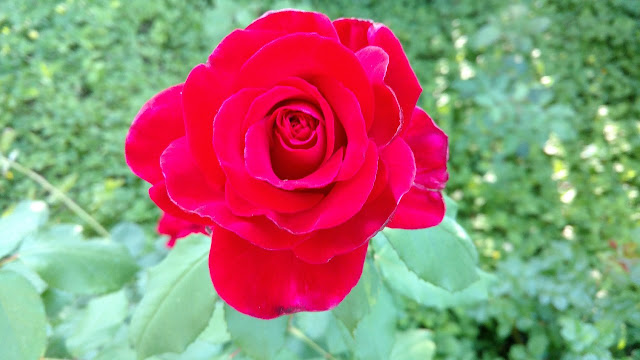
Look at the roots — if you can

|
| This beauty is an Olympiad rose. (Photo: Debbie Arrington) |
Bare-root season is when rose lovers go shopping. Now appearing in local nurseries (or coming soon) are bare-root rose bushes, ready for planting.
“Bare-root” means just what it says; the roots are bare and free from soil. Since roots will determine the strength of future growth, it’s an opportunity to check them out – as well as the above-ground portions of the plant.
These mature rose bushes, at least 2 years old and often older, were “harvested” in October or early November. That’s when they were dug out of fields, often here in California’s Central Valley. (Arizona and Texas also are major rose bush producers.) After harvest, the bushes were placed in cold (not freezing) storage with their roots loosely packed in sawdust or straw. That helps the roots retain their moisture.
Displayed in nurseries, the bare-root bushes often are still standing in sawdust. When browsing, choose a bush with at least three strong canes. Then, pull it out of the sawdust and look at the roots. Ideally, there should be at least three strong roots to match the canes above ground.
What if you can’t see the roots? That’s the case with plastic-wrapped bare-root roses, sold at nurseries as well as home improvement centers and supermarkets. That’s when you have to rely on grades.
Field-grown grafted rose bushes are graded on a scale established by the American Association of Nurseryman. “Grade 1” roses are considered the best.
Under these rules, the Grade 1 standard for hybrid teas includes at least three strong canes (with two at least 18 inches long), well spaced around the graft – where the rootstock connects to the budwood. Grade 1-1/2 roses have two strong canes. Grade 2 roses are overall smaller in size with at least two canes, 12 inches long.
Wrapped or unwrapped, what you do with that rose when you first get it home is the same: Re-hydrate it. That bush is thirsty.
Before planting your new rose bush, soak the roots in a bucket of water overnight. If weather conditions or your garden soil are too wet to plant, the bare-root bush can stay in water for several days.
For more on roses including new varieties, check out the American Rose Society website at https://www.rose.org/ .
Comments
0 comments have been posted.Sacramento Digs Gardening to your inbox.
Sites We Like
Garden Checklist for week of July 21
Your garden needs you!
* Keep your vegetable garden watered, mulched and weeded. Water before 8 a.m. to reduce the chance of fungal infection and to conserve moisture.
* Feed vegetable plants bone meal, rock phosphate or other fertilizers high in phosphate to stimulate more blooms and fruiting. (But wait until daily high temperatures drop out of the 100s.)
* Don’t let tomatoes wilt or dry out completely. Give tomatoes a deep watering two to three times a week.
* Harvest vegetables promptly to encourage plants to produce more. Squash especially tends to grow rapidly in hot weather. Keep an eye on zucchini.
* Pinch back chrysanthemums for bushy plants and more flowers in September.
* Remove spent flowers from roses, daylilies and other bloomers as they finish flowering.
* Pinch off blooms from basil so the plant will grow more leaves.
* Cut back lavender after flowering to promote a second bloom.
* It's not too late to add a splash of color. Plant petunias, snapdragons, zinnias and marigolds.
* From seed, plant corn, pumpkins, radishes, winter squash and sunflowers.